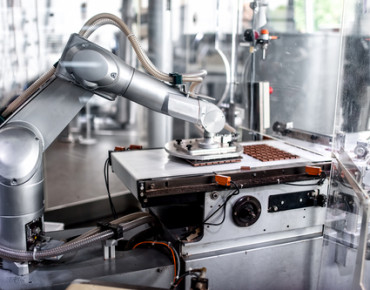Four Ways to Benefit from Robotic Process Automation

News about automation and its socio-economic impact is all around us today. While some automation been around for decades, the last two years have seen exponential progress in its capability and potential impact. But progress, especially in large companies, remains mixed. Research shows that while more than 80 percent of large enterprises have a high or extremely high emphasis on digital technologies like automation, less than 10 percent realize the expected benefits. The machine's enemy? We have seen it, and it is us.
So how do large enterprises unlock the full potential impact from automation technologies such as rapid or robotic process automation (RA)?
First, prioritize right: the goal of process automation is to help allocate human intellectual capital where it can deliver maximum value, not to scrape a few bucks here and there. RA should, therefore, not only be about reducing human resources and driving short term cost and productivity improvements. Enterprises should look at this as part of their overall value creation process and as one of an end-to-end suite of tools, capabilities, and assets that can help accelerate business transformation. It is a means to completely re-imagine how business processes are executed, and human skills are applied where they are uniquely valuable.
Second, understand today’s potential of process automation technology, not yesterday’s. RA embeds significant intelligence including the ability to handle non-standard and unstructured inputs and perform activities like screen searching. For example, to capture an alphanumeric invoice number, RA solutions can be programmed to locate it anywhere on an image.
Increasingly, RA solutions embed additional component technologies as mash-ups to augment scope, capability, and therefore impact. These technologies can be around natural language generation and processing, big data analytics, or advanced cognitive capabilities. For example, RA solutions with embedded cognitive computing capabilities can use complex algorithms to take more informed decisions. Combined with linguistics (speech and text) and image processing, this class of systems can enable user-system interaction in natural language. An application may be improving the underwriting decision-making process by driving uniformity through automated recommendation engines that can dynamically consolidate and interpret geospatial, text and image-based information.
Third, automating broken processes is a common mistake. Process optimization maximizes the value that can be unlocked through automation. Companies often take the easier approach of implementing RA on broken and suboptimal processes. As Stefan Thomke points out in a recent Harvard Business Review post, you can try to automate a broken process, but it won't help as it only cements the inefficiencies inherent in the system. Therefore, the right approach is to first re-engineer the process and then combine process optimization with appropriate operating models and RA technologies to maximize the outcome. It’s important to understand that process redesign shouldn’t be attempted with the narrow objective of automation alone. Ultimately, the redesign should enable business transformation and automation is one component of how superior outcomes can be achieved in the redesigned process.
Finally, to realize benefits faster, enterprises should typically start to look at automating work that is already industrialized and optimized. For example, in finance and accounting, it can be invoicing, payables, reporting and master data management, or perhaps claims processing in insurance.
Following the right approach can have a massive impact for large companies. Depending on the nature of work, our experience shows RA implemented on an optimized process can deliver:
- Cycle time reduction and response time improvement up to 99 percent, for example in insurance claims data management
- More than 50 percent improvement in productivity of human resources for example in order to cash processes
- About 85 percent improvement in time-to-market if one considers the end-to-end time required to execute projects through a redesigned approach versus the traditional resource-driven model, and;
- One hundred percent accuracy and therefore significant improvement in terms of risk and compliance; the benefit of RA from a risk management and compliance angle is often overlooked especially in industry-specific processes that are heavily scrutinized and regulated.
RA allows greater visibility into processes that span enterprise functions and enables an enhanced information feedback loop in terms of speed, accuracy and volume of data. This feedback loop empowers enterprises to sense, act, and learn from the outcome of their actions at scale, resulting in business operations that are truly intelligent.
While a broad section of the enterprise market is in the education phase today, the first wave of RA adopters have experienced what works and what doesn’t. As business models across the spectrum are fundamentally disrupted, enterprises should examine the synergistic capabilities of machines and humans and follow the right approach to realize the full potential of process automation.
About the Author
Subroto Gupta is vice president, Digital Transformation & Innovation at Genpact, where he applies digital technologies and collective intelligence to innovate and transform global businesses. He has over 18 years of global leadership experience delivering tangible business outcomes across roles in sales, marketing, operations, and enterprise scale innovation programs in large B2B companies. In the area of social network analytics and unified collaboration, Subroto has developed new service offerings that leverage technology, process, and practices to improve operational effectiveness, governance, and knowledge management. In collective intelligence and crowdsourcing, he has led projects that create disruptive value around cost, capability and flexibility. An alumnus of MIT’s Sloan School of Management, Subroto is an accomplished author whose work has been featured in numerous leading international publications. Follow him on Twitter at: @SubrotoGupta or @Genpact_Ltd.
Related
Managing editor of Enterprise Technology. I've been covering tech and business for many years, for publications such as InformationWeek, Baseline Magazine, and Florida Today. A native Brit and longtime Yankees fan, I live with my husband, daughter, and two cats on the Space Coast in Florida.











